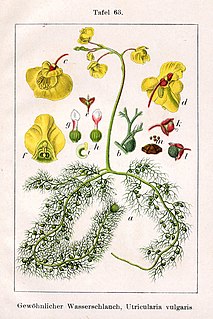
Utricularia, commonly and collectively called the bladderworts, is a genus of carnivorous plants consisting of approximately 233 species. They occur in fresh water and wet soil as terrestrial or aquatic species across every continent except Antarctica. Utricularia are cultivated for their flowers, which are often compared with those of snapdragons and orchids, especially amongst carnivorous plant enthusiasts.
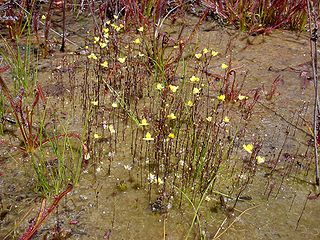
Utricularia subulata, the zigzag bladderwort, is a small annual, terrestrial carnivorous plant that belongs to the genus Utricularia. It is the most widely distributed species in the genus, being almost pantropical.
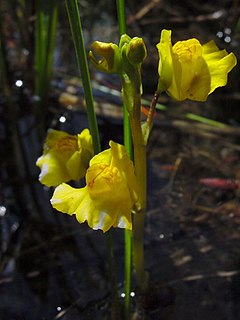
Utricularia sect. Utricularia is a section in the genus Utricularia. The species in this section are suspended or affixed aquatic carnivorous plants.

Utricularia inflexa is a medium to large sized suspended aquatic carnivorous plant that belongs to the genus Utricularia. It is probably a perennial plant. U. inflexa is endemic to Africa and the Indian subcontinent.
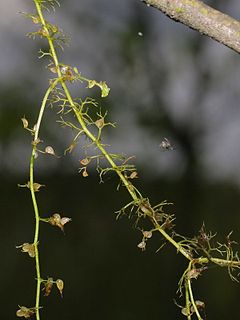
Utricularia minor, the lesser bladderwort, is a small, perennial carnivorous plant that belongs to the genus Utricularia. It is usually found affixed to the substrate but it can also survive suspended in a body of water. U. minor is a circumboreal species and is found in North America, Asia, and Europe.

Utricularia intermedia, the flatleaf bladderwort or intermediate bladderwort is a small, perennial carnivorous plant that belongs to the genus Utricularia. It is usually found affixed to the substrate but it can also survive suspended in a body of water. U. intermedia is a circumboreal species and is found in North America, Asia, and Europe.

Utricularia radiata, the little floating bladderwort, is a medium-sized suspended aquatic carnivorous plant that belongs to the genus Utricularia. U. radiata is endemic to North America.

Utricularia stellaris is a medium to large sized suspended aquatic carnivorous plant that belongs to the genus Utricularia. U. stellaris is native to Africa, tropical Asia, and northern Australia.

Utricularia purpurea, the eastern purple bladderwort, is a medium-sized suspended aquatic carnivorous plant that belongs to the genus Utricularia. U. purpurea is endemic to North and Central America. It has been suggested that U. purpurea may have partially lost its appetite for carnivory. Richards (2001) did an extensive study in the field on it and noted that trapping rates of the usual Utricularia prey were significantly lower than in other species in the genus. Richards concludes that this species can still trap and digest arthropod prey in its specialized bladder traps, but does so sparingly. Instead, it harbors a community of algae, zooplankton, and debris in the bladders that indicates U. purpurea favors a mutualistic interaction in place of a predator–prey relationship.
Peter Geoffrey Taylor (1926–2011) was a British botanist who worked at Royal Botanic Gardens, Kew throughout his career in botany. Taylor was born in 1926 and joined the staff of the herbarium at Kew in 1948. He published his first new species, Utricularia pentadactyla, in 1954. In 1973, Taylor was appointed curator of the orchid division of the herbarium and, according to Kew, "under his direction, orchid taxonomy was revitalised and its horticultural contacts strengthened."

Utricularia subg. Bivalvaria is a subgenus in the genus Utricularia. It was originally described by Wilhelm Sulpiz Kurz in 1874. In Peter Taylor's 1989 monograph on the genus, he reduced the subgenus to synonym under section Oligocista, a decision that was later reversed in the light of molecular phylogenetic studies and the subgenus was restored.

Utricularia cornuta, the horned bladderwort, is a small to medium-sized, probably perennial carnivorous plant that belongs to the genus Utricularia. U. cornuta is endemic to North America and can be found in the Bahamas, Cuba, Canada, and the United States. It grows as a terrestrial or subaquatic plant in marshes, swamps, and pools in shallow waters, mostly at lower altitudes. It was originally described and published by André Michaux in 1803.
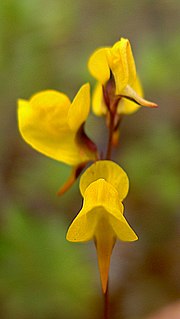
Utricularia juncea, the southern bladderwort, is a small to medium sized, probably perennial carnivorous plant that belongs to the genus Utricularia. U. juncea is native to Central, South, and North America. It grows as a terrestrial plant in marshes, swamps, and pools in shallow waters, mostly at lower altitudes. It was originally described and published by Martin Vahl in 1804.

Utricularia sect. Oligocista is the largest section in the genus Utricularia. The 42 species in this section are small to medium-sized terrestrial carnivorous plants native throughout the tropics, with six species in the Americas, ten in Africa, five in Australia, and the remainder in Asia, with 17 mostly native to peninsular India. Alphonse Pyrame de Candolle originally described and published this section in 1844. Peter Taylor published his taxonomic monograph of Utricularia in 1986, in which he placed this section within subgenus Utricularia. More recent phylogenetic data and revisions have reinstated subgenus Bivalvaria and have placed this section within it.

Utricularia sect. Setiscapella is a section in the genus Utricularia that contains small or medium-sized terrestrial or subaquatic species. Most plants in this section are endemic to Central and South America with the exceptions of Utricularia stanfieldii, which is endemic to Africa, and Utricularia subulata which is almost pantropical. It was first described by John Hendley Barnhart in 1916 at the rank of genus. In 1973, Sadashi Komiya reduced the genus to a subgenus of the genus Utricularia. In his 1986 monograph on the genus, Peter Taylor reorganized the genus and reduced this to the rank of section.

Agalmatidae, or Agalmidae, is a family of siphonophores.

The Genus Utricularia: A Taxonomic Monograph is a monograph by Peter Taylor on the carnivorous plant genus Utricularia, the bladderworts. It was published in 1989 by Her Majesty's Stationery Office (HMSO) as the fourteenth entry in the Kew Bulletin Additional Series. It was reprinted for The Royal Botanic Gardens, Kew in 1994.

The North American Continent is home to a wide variety of carnivorous plant species. Species from seven genera are native to the continent, and three of these genera are found nowhere else on the planet.
















